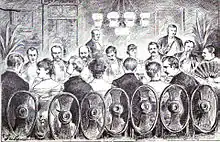Fredericka "Marm" Mandelbaum | |
|---|---|
 | |
| Born | Fredericka Weisner March 25, 1825 |
| Died | February 26, 1894 (aged 68) |
| Other names | Fredericka Mandlebaum |
| Occupation | Criminal |
| Known for | Criminal fence and underworld figure in New York City during the mid-to late 19th century. |
| Spouse | Wolfe Mandelbaum |
Fredericka "Marm" Mandelbaum (March 25, 1825 – February 26, 1894)[1] [2][3] operated as a criminal fence to many of the street gangs and criminals of New York's underworld, handling between $1–5 million in stolen goods between 1862 and 1884. Like her principal rival John D. Grady and the Grady Gang, she also became a matriarch to the criminal elements of the city and was involved in financing and organizing numerous burglaries and other criminal operations throughout the post-American Civil War era.[4] With George Leonidas Leslie, she was involved in the 1869 Ocean National Bank robbery and the 1878 Manhattan Savings Institution robbery.
Life and career

Mandelbaum was born Friederike Weisner in Kassel, a city in modern-day Germany. Not much is known of her early life, other than that her family was Jewish. She married Wolfe Mandelbaum in 1848; they worked as itinerant peddlers in Germany before emigrating to the United States in 1850.[1]
When the family arrived in New York, they began a series of small businesses, taking in goods collected by scavengers and reselling them. The pair purchased a dry goods store on Clinton Street, but by 1854, the business was operating as a front for the Mandelbaums' criminal operations (she would later need to store goods in two large warehouses in the city). Mandelbaum began financing thieves and burglars and was involved in planning some of the biggest thefts in the city's history, including the Ocean National Bank.[5] Expanding her operations, she controlled several gangs of blackmailers and confidence men as well as a school, known as Marm's Grand Street School, to recruit and teach younger criminals how to pickpocket.[6] She was also a top competitor to the Grady Gang.
During this time, she had become one of New York's most prominent hostesses of New York's high society, as well as the underworld, regularly associating with some of the most well-known criminals of the day including Queen Liz, Big Mary, "Black" Lena Kleinschmidt, Adam Worth, Sophie Lyons, and George Leonidas Leslie as well as judges and police officials.
However, in 1884, New York District Attorney Peter B. Olney hired the Pinkerton Detective Agency to infiltrate Mandelbaum's organization. An agent, posing as a prospective thief, arranged to have several marked bolts of silk stolen from a store where it was discovered in a police raid on her home the following morning. Arrested with her son Julius and clerk Herman Stroude, Mandelbaum was released on bail and fled the United States with an estimated $1 million. She settled in Hamilton, Ontario where she remained until her death in 1894.[7]
References
- 1 2 Holub, Rona. "Fredericka Mandelbaum." In Immigrant Entrepreneurship: German-American Business Biographies, 1720 to the Present, vol. 2, edited by William J. Hausman. German Historical Institute. Last modified October 15, 2013.
- ↑ Holub, Rona L. (April 2008). "Mandelbaum, Fredericka (1827-1894), criminal entrepreneur". American National Biography. Oxford University Press. doi:10.1093/anb/9780198606697.article.2001903. ISBN 978-0-19-860669-7. Retrieved March 29, 2021.
- ↑ Conway, J. North (Aug 4, 2009). King of Heists: The Sensational Bank Robbery of 1878 That Shocked America. Globe Pequot. ISBN 9781599218359.
- ↑ Jim Naureckas. "Rivington Street: New York Songlines". Nysonglines.com. Retrieved 2010-03-08.
- ↑ "The architect who became the king of bank robberies - Business News". 2022-08-19. Retrieved 2023-04-23.
- ↑ Mackenzi, Lee (2018-02-27). Bygone Badass Broads : 52 Forgotten Women Who Changed the World. Eriksson, Petra (Illustrator). New York. ISBN 9781419729256. OCLC 1000582947.
{{cite book}}: CS1 maint: location missing publisher (link) - ↑ Hamilton Spectator, February 26, 1894
Sources
- Asbury, Herbert. The Gangs of New York. New York: Alfred A. Knopf, 1927. ISBN 978-1-56025-275-7
- Sifakis, Carl. The Encyclopedia of American Crime. New York: Facts on File Inc., 2001. ISBN 978-0-8160-4040-7
- Phillips, Charles and Alan Axelrod. Cops, Crooks, and Criminologists: An International Biographical Dictionary of Law Enforcement, Updated Edition. New York: Checkmark Books, 2000. ISBN 978-0-8160-3016-3
Further reading
- Asbury, Herbert. All around the town: The Sequel to the Gangs of New York. New York: Alfred A. Knoff, 1929. ISBN 978-1-56025-521-5
- Conway, J. North (2009). King of Heists: The Sensational Bank Robbery of 1878 That Shocked America. The Lyons Pesss. ISBN 978-1-59921-538-9.
- Lardner, James and Thomas Reppetto. NYPD: A City and Its Police. New York: Henry Holt & Co., 2000. ISBN 978-0-8050-6737-8
- Ben Macintyre, "The Napoleon of Crime; The Life and Times of Adam Worth, Master Thief," 1997.
External links
- Adam Worth: The World in his Pocket - Marm Mandelbaum by Joseph Geringer
- Frederika "Ma" Mandlebaum at Rotten.com
- The Sins of New York: As "Exposed" by the Police Gazette by Edward Van Emery
- WNYC - The Next Big Thing: Out Laws (Queen of Fences)
- "Marm - A Gilded Age Mastermind" by William Bryk - New York Sun - December 22, 2004